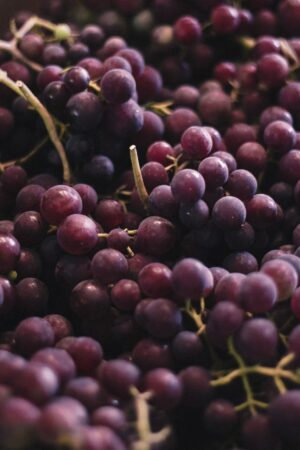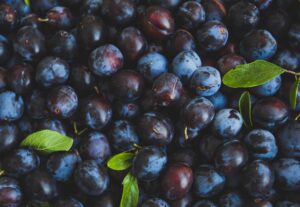California table grapes, stone fruit grappling with storm’s effects
Weeks after it brought Southern California its first-ever tropical storm watch before making landfall over the northern Baja California Peninsula in Mexico, Hurricane Hilary’s effects on California crops is still being assessed.
One thing that’s clear is that the storm, unusual for its maintained strength despite cool ocean waters and prevailing east-to-west trade winds, made a significant impact on the state’s table grapes and stone fruit.
Hilary hit California at peak harvest time for most of the 90 varieties of table grapes grown in the state, drenching some regions with record-breaking rain. Kathleen Nave, president of the California Table Grape Commission, said Tuesday that growers are scrambling to save what they can.

“In the places that were hit by rain, and those are many places, many vineyards — not everywhere, but many — they’re doing everything they can to mitigate the damage,” Nave said. “If they can stop mold from growing or mildew, they’re doing everything they can to mitigate, and then, they’re going to pick any bunches that are still good and healthy. But it’s going to be very slow.”
Approximately 30% of the crop was harvested when the storm hit, according to commission estimates. Projections indicate 35% of the remaining crop, or 25 million boxes, has been lost.
That leaves the revised estimate for the California crop at 71.9 million 19-pound boxes. The last time state’s crop was under 75 million boxes was 1994.
California stone fruit also felt the effects of Hilary, which dumped rain on fruit sizing up and boasting good Brix levels.
“A high sugar content mixed with rain on the exterior really is a recipe for disaster,” Ian LeMay, president of the California Fresh Fruit Association, said Wednesday. “We definitely saw significant damage in stone fruit. Depending on the block, you could see north of 50% to 85% loss. It depends on regionality, where a certain orchard might be, and where the storm ultimately decided to drop rain or not.”
However, like table grapes, stone fruit — including late-season peaches, plums and some nectarines — is typically harvested into and through fall, so “there is a crop to harvest,” LeMay said. “There is product to move into the retail space space and to the end consumer to enjoy for the remaining portions of the season.”

More than 60% of California’s table grape crop is typically shipped after Sept. 1, Nave said, and the 45 million-plus boxes of grapes the industry still plans to ship will mainly reach North American markets.
“There will be fewer grapes available across the country, but I do think that where we will see the most impacts is in export markets,” she said. “The bulk of what’s left is probably going to stay in the U.S., perhaps Canada and Mexico. But there will be fewer grapes. It is our hope that consumers won’t see much of a difference at retail, but they may.”
For the portion of crops that can be salvaged, the already painstaking process of culling berries and shaping bunches will be even slower.
“For that reason, it’s going to be a lot more expensive for growers,” Nave said. “I’m happy to say that, so far, we’re hearing that retailers understand that. They are increasing the prices that they’re going to pay, at least some of them are, for the boxes that are going to be shipped.”
Nave said the increased expense to retailers doesn’t have to be noticeably passed on to consumers.
“There is room between the price that growers are typically paid for grapes and what consumers are charged,” she said. “If you think about it on a per-pound basis, there’s room for retailers to pay growers more without necessarily having to raise the prices to consumers, or at least not to raise them much.”
LeMay also called on retailers to be flexible, understanding a piece of fruit may bear some evidence of water or that size specifications may change based upon harvesting capabilities.
“This is a historic event, possibly a once-in-a-century weather event, that happened,” he said. “This is not our industry coming to our retail partners and asking for long-term changes or flexibilities. This is us coming to them asking them to acknowledge the significant reality of what our industry is dealing with.”
Nave said the California Table Grape Commission is exploring disaster relief measures for growers as well as looking into helping farmworkers who stand to lose a chunk of income.
“If you just think about the harvest function and think that 35% of what was left to do is now gone, that’s going to have a big impact on the farmworking community,” she said. “Paychecks are going to be smaller. There’s going to be less for them to do.”
As the commission works to promote the remaining table grape crop, Nave encouraged consumers to speak up if they don’t see California grapes on local shelves.
“That matters, because it’s important for produce managers to hear that you’re interested,” she said. “That word filters up to the people who make the buying decisions.”
Nave and LeMay agree reason for optimism remains.
“We don’t typically get rain, let alone hurricanes, in August, but we do get rain in September and October and November, and different varieties take rain differently,” Nave said. “Some of them take it a little better than others. So yes, there are definitely grapes. And we are still shipping out of cold storage right now, so we might be shipping some fruit that’s been picked since the rain, but we’re still shipping fruit that was already picked.
“So there will definitely be grapes. We just don’t know exactly how many.”
The end goal, LeMay said, is to make sure high-quality California fruit is still available.
“As growers and farmers always try to do, we will try to do the best we can to get back out there in the vineyards and the orchards, to assess the damage, to harvest the quality fruit that still exists, and to get that fruit to the consumer,” he said. “But the challenge will continue.”







